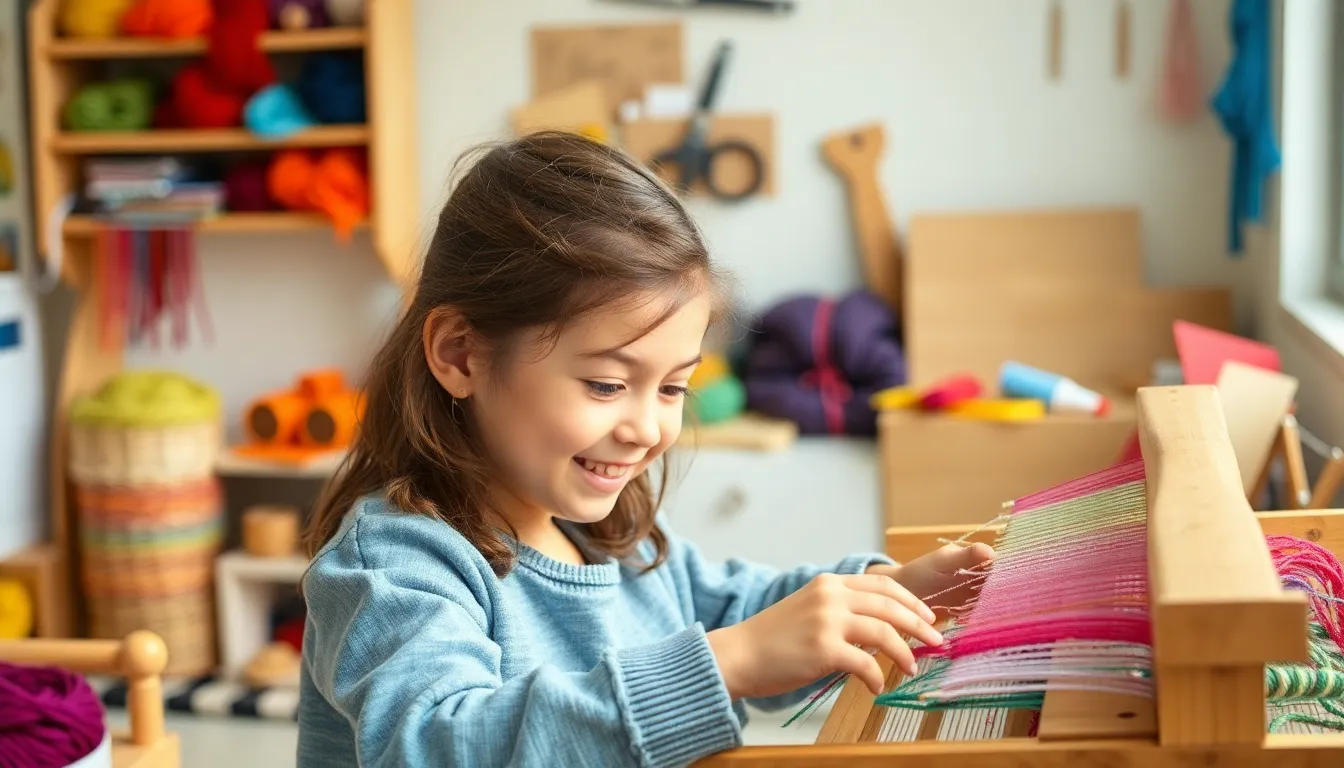Table of Contents
ToggleWeaving isn’t just for grandmas anymore; it’s a vibrant adventure waiting for kids to dive into! Imagine little hands creating colorful masterpieces while developing fine motor skills and unleashing their creativity. Weaving for kids is more than just a craft; it’s a ticket to a world where imagination runs wild and boredom takes a backseat.
Overview of Weaving Kids
Weaving captivates children by combining creativity and skill-building. This engaging activity supports the development of fine motor skills, crucial for tasks like writing and buttoning shirts. Many children experience joy while creating colorful pieces, allowing personal expression through textile art.
Materials for weaving include yarn, looms, and various decorative elements. These components inspire kids to explore textures and colors, stimulating sensory exploration. Engaging in projects like friendship bracelets or wall hangings provides a tangible outcome, which girls and boys can take pride in after completion.
Classes and workshops often offer structured learning environments for weaving. Children benefit from guidance by experienced instructors who introduce basic techniques and encourage individual style. With practice, kids learn to tackle more complex patterns and designs, enhancing problem-solving skills.
Community events also promote weaving as a collaborative effort. Kids interact with peers while sharing ideas and techniques, fostering social skills. Such environments instill teamwork and communication, preparing them for future group projects.
Parents often notice behavioral improvements in kids involved in weaving activities. Increased focus and concentration arise, beneficial traits that transfer to academic settings. Furthermore, producing unique woven pieces reinforces a sense of accomplishment, boosting confidence in their creative abilities.
As a modern revival, weaving remains an accessible and enriching pastime for children. This colorful craft matters because it nurtures imagination, encourages exploration, and promotes important life skills.
Benefits of Weaving for Children

Weaving offers multiple benefits for children, enriching their development and providing enjoyable experiences. The activity enhances creativity and hones fine motor skills, making it a valuable pastime.
Enhancing Creativity
Weaving encourages children to express their artistic vision. They explore colors, patterns, and textures freely while creating unique projects. Projects like friendship bracelets or wall hangings allow for personal interpretation and innovation. Kids experiment with materials, expanding their understanding of design principles. Engaging in weaving nurtures imaginative thinking, helping them connect ideas in new ways. The creative process fosters problem-solving abilities, as they navigate challenges during their projects. By having the freedom to create, children cultivate a sense of ownership over their work and gain confidence in their artistic skills.
Developing Fine Motor Skills
Weaving significantly improves fine motor skills in children. Manipulating yarn and thread requires precision and coordination. Activities strengthen hand-eye coordination as kids learn to manage tools like looms and needles. Repeated movements enhance dexterity, benefiting activities such as writing and drawing in the long run. Children develop grip strength crucial for everyday tasks while mastering weaving techniques. As they progress, they gain control over their finger movements, leading to increased independence. Engaging in this hands-on craft provides opportunities to refine these essential skills, ultimately supporting their overall development.
Popular Weaving Techniques for Kids
Weaving provides various techniques that engage kids creatively while enhancing their skills. Two popular methods include finger weaving and loom weaving.
Finger Weaving
Finger weaving offers a straightforward approach, using just fingers and yarn. Kids create intricate designs without any tools, making it accessible for beginners. This technique promotes dexterity, enabling children to manipulate yarn with precision. Various patterns can emerge, from simple braids to more complex designs. Skills involved in finger weaving help build fine motor coordination, fostering independence as they explore their creativity. Engaging in this method often results in quick rewards, as children can see their creations come to life almost immediately.
Loom Weaving
Loom weaving introduces children to a structured way of crafting. Using looms, kids learn to weave yarn in an organized manner, making projects like blankets and scarves. Various loom types cater to different skill levels, allowing for gradual progression. This technique enhances critical thinking as children plan their projects and select colors. The tactile aspect of working with a loom nurtures sensory exploration, while the rhythmic actions involved promote focus. Children often develop a sense of accomplishment once they complete a loom weaving project, encouraging them to continue their weaving journey.
Recommended Weaving Kits and Tools
Weaving kits and tools provide everything needed for children to dive into this creative craft. They help support kids as they explore new skills and unleash their imagination.
Best Kits for Beginners
Beginner-friendly kits often include simple looms, colorful yarn, and easy-to-follow instructions. Brands like Klutz offer a weaving kit perfect for first-time weavers, complete with materials to create finger knits and wall hangings. Another popular choice is the Craft-tastic Weaving Kit, featuring pre-cut cards and vibrant threads for hassle-free setup. Kids appreciate kits that inspire creativity while ensuring fun learning experiences. These kits serve as excellent starting points for budding weavers.
Essential Tools for Weaving Projects
Essential tools contribute to the weaving experience, enhancing creativity and skill development. Basic looms, such as the Melissa & Doug Mini Weaving Loom, make it easy for kids to create scarves and bracelets. High-quality yarns feature various textures and colors, encouraging sensory exploration. Scissors and yarn needles assist in completing projects with neat finishes. Lastly, a weaving board, like the one from HPN, provides structure for stable, intricate designs. Each tool plays a critical role in helping children develop their weaving techniques and express their artistic ideas.
Weaving offers children a unique blend of creativity and skill development. As they engage in this vibrant craft, they not only create beautiful projects but also enhance their fine motor skills and problem-solving abilities. The variety of techniques available ensures that every child can find joy in weaving, whether through finger weaving or loom projects.
With the right tools and guidance, kids can embark on a rewarding journey that fosters independence and teamwork. As weaving continues to gain popularity, it stands out as an enriching activity that nurtures imagination and supports essential life skills. Embracing weaving can lead to a world of creativity and exploration for the younger generation.







